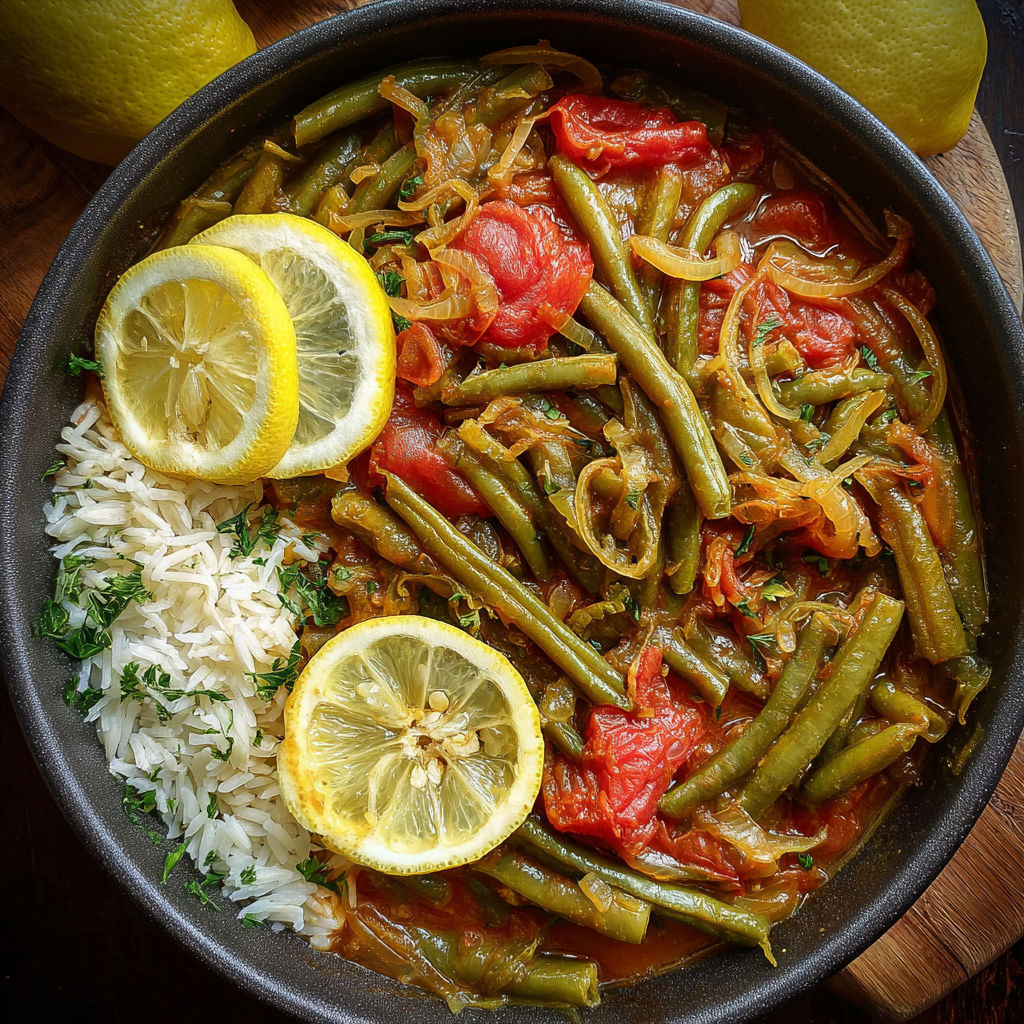 Pin
Pin
This vibrant Vegan Lebanese Green Bean Stew has been a cornerstone of my plant-based Mediterranean cooking journey, bringing warmth and comfort to my table through all seasons. The tangy tomato-based sauce perfectly balances the tender green beans, creating a dish that's both nourishing and deeply satisfying.
I first discovered Loubyeh w Riz while exploring my Lebanese heritage through cooking. What began as curiosity quickly became a weekly staple in my home, with my skeptical partner now requesting it regularly, especially with a generous squeeze of fresh lemon.
- Fresh or frozen green beans Choose thin French green beans for quicker cooking time though traditional Lebanese recipes use flat wide beans
- Olive oil Use a good quality extra virgin olive oil for the best flavor foundation
- Onions They create the aromatic base that defines this stew
- Garlic Fresh cloves add depth that powder simply cannot match
- Fresh tomatoes They provide texture contrast to the softened beans
- Tomato sauce Brings body and richness to the stew
- Red pepper flakes Adds gentle warmth that builds with each bite
- Fresh lemon juice The essential bright acidity that makes this dish sing
- Salt Enhances all the flavors and brings everything together
How To Make Vegan Lebanese Green Bean Stew
- Prepare the rice base
- Begin by making vermicelli rice according to your preferred recipe. The toasted vermicelli noodles create a nutty foundation that perfectly complements the tangy stew.
- Create the aromatic base
- Heat olive oil in a large pot over medium heat until it shimmers. Add diced onions and sliced garlic, cooking for about 5 minutes until they become translucent and fragrant. This foundation builds the complex flavor profile of the entire dish.
- Soften the green beans
- Add green beans and diced tomatoes to the aromatic base. Cover the pot to trap steam and cook for 5 minutes, stirring once halfway through. The beans will begin to brighten in color as they start to tenderize.
- Develop the stew
- Pour in tomato sauce, stir thoroughly to coat all ingredients, then reduce heat to low. Cover and allow to simmer for 40 minutes, stirring occasionally to prevent sticking. During this time, the beans will absorb the flavors while softening to the perfect texture.
- Brighten with seasonings
- Once beans are tender, add salt, red pepper flakes, and fresh lemon juice. The lemon transforms the dish, cutting through the richness of the tomato base. Cover and cook for 5 more minutes to allow flavors to meld completely.
- Serve with intention
- Spoon the vibrant stew over a bed of vermicelli rice and accompany with fresh vegetables like radishes, bell peppers, and jalapeños for textural contrast and additional nutrients.
The fresh lemon juice is truly the secret weapon in this recipe. I remember my grandmother squeezing lemons with her weathered hands, insisting that bottled juice would never compare. She was right. The brightness that fresh citrus brings to this stew transforms it from good to extraordinary, cutting through the richness of the tomato base.
Perfect Pairing Suggestions
Lebanese cuisine is all about complementary dishes that create a complete experience. Serve this stew alongside fresh pita bread for scooping up the flavorful sauce. A simple cucumber and tomato salad dressed with lemon and olive oil provides a refreshing counterpoint to the rich stew. For a true feast, add hummus, baba ganoush, and tabbouleh to create a mezze spread that will transport your guests to the Mediterranean.

Make-Ahead And Storage Tips
This stew is ideal for meal preparation as it actually improves with time. Store in an airtight container in the refrigerator for up to 5 days, allowing the flavors to deepen and meld. Reheat gently on the stovetop with a splash of water if needed to loosen the sauce. For longer storage, freeze portions in freezer-safe containers for up to 3 months. I recommend freezing the stew separate from the rice for best texture upon reheating.
The Cultural Significance
Loubyeh w Riz represents the heart of Lebanese home cooking. This humble dish showcases the Lebanese philosophy of transforming simple ingredients into nourishing meals through patience and technique. Traditionally served during the summer when green beans are abundant, this stew has sustained families for generations. In Lebanese homes, this dish often appears on the table during casual family gatherings, where everyone helps themselves from a central pot, breaking bread together in the true Mediterranean tradition.

Recipe FAQs
- → What type of green beans work best for Loubyeh w Riz?
While traditional Lebanese Loubyeh w Riz uses flat, wide green beans, French thin green beans (haricots verts) work beautifully too. Both fresh and frozen options yield excellent results, making this dish accessible year-round.
- → Can I make this dish ahead of time?
Yes! This Lebanese green bean stew actually improves with time as the flavors meld together. You can prepare it 1-2 days in advance and store in the refrigerator. Reheat gently on the stovetop before serving with freshly made vermicelli rice.
- → How do I prepare the vermicelli rice mentioned in the ingredients?
Vermicelli rice involves toasting broken vermicelli pasta in butter or oil until golden brown, then adding rice and water to cook together. The result is a fragrant, nutty rice dish that perfectly complements the tangy green bean stew.
- → Is Loubyeh w Riz traditionally vegan?
While some versions may include meat, this vegan version is completely authentic to Lebanese cuisine. Many Lebanese dishes are naturally plant-based, especially those served during religious fasting periods when animal products are avoided.
- → What can I serve alongside this dish?
Traditional accompaniments include fresh vegetables like radishes, bell peppers, and jalapeños. A simple salad with lemon and olive oil dressing, pickled turnips, or Lebanese-style pickles (kabees) also make excellent sides to complete the meal.
- → Can I reduce the amount of lemon juice?
The bright acidity from lemon juice is characteristic of this dish, but you can adjust to taste. Start with juice from 3 lemons instead of 5, then add more to reach your preferred level of tanginess after tasting.
